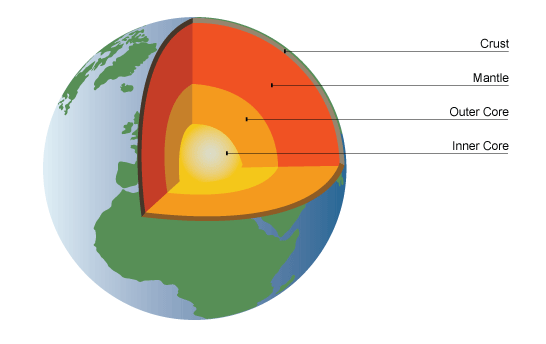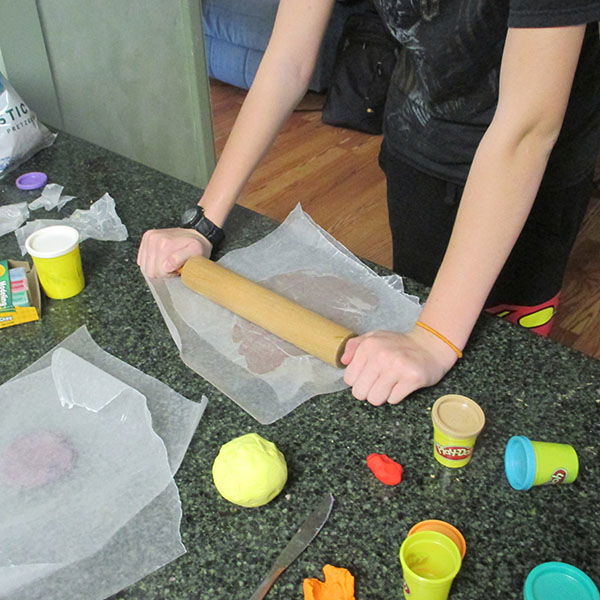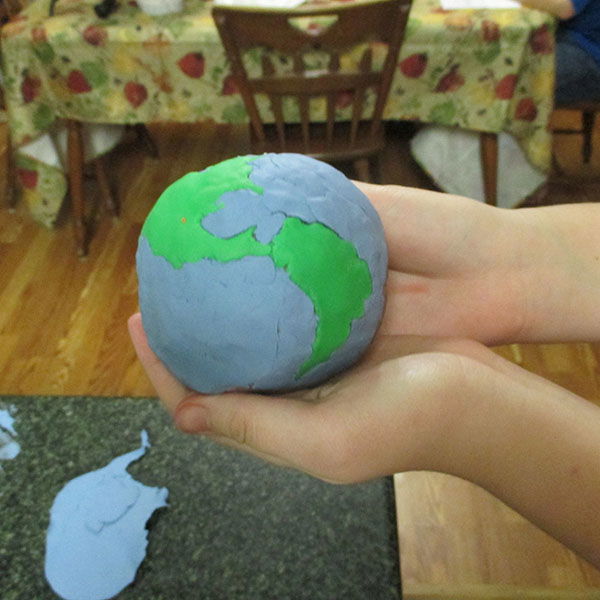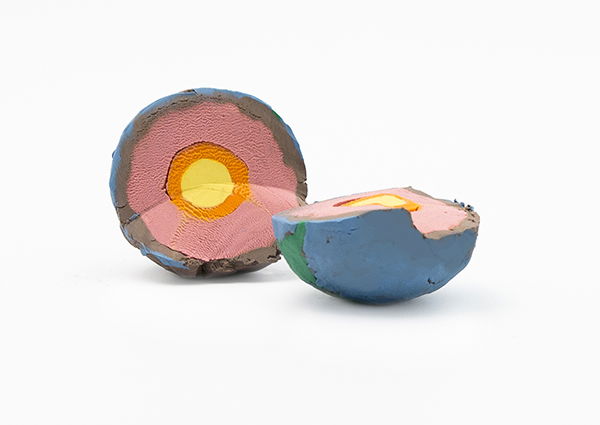Build a Model of the Earth
Have you ever wondered what the earth looks like on the inside? What is it made of? How can we find out? These are great questions, considering that the center of the earth is nearly 4,000 miles (6,437 km) below its surface, making it difficult to explore!
One way to study the inside of the earth is to drill holes and examine what is found. The deepest hole that has been drilled into the earth is the Kola Superdeep Borehole, which is located on the Kola Peninsula in Russia. It is only approximately 7.5 miles (12 km) deep and 9 inches (23 cm) in diameter. The drilling had to stop because internal temperatures of 356°F (180°C) at that depth became too hot to continue!1
Even without drilling, scientists have devised interesting methods to study what lies inside the earth. Have you thrown a stone into a pond and watched as waves moved through the water? There are waves that can pass through the earth too, called seismic waves. Seismic waves are generated during earthquakes and move at varying speeds when passing through different types of solids and liquids. Scientists can collect data from the way that seismic waves behave when passing through the earth, and theorize at what is inside of it.
Earthquakes generate various seismic waves . . . that travel through the earth’s interior. By analyzing how these waves change behavior when they reach different regions, we can learn where the density changes significantly. At a depth of about 1,796 miles (2,890 km), an abrupt change indicates a sudden increase in density. This corresponds to the core-mantle boundary.
If we look at a chart of different metal densities, iron best fits the density at the core, and olivine (a magnesium-iron silicate mineral) best fits the mantle. Even though the core is made of the same basic iron material, certain seismic waves travel differently through the outer core, indicating that it must be liquid, while the inner core is solid.2
Scientists have determined that the earth layers consist of the crust, mantle, outer core, and inner core.

There is liquid water in the crust layer of the earth in pore spaces and crevices. However, there is a great deal more water found in the earth’s mantle, but it is trapped inside crystal structures, not in liquid form. This water can be released from the rock when it melts, such as occurs to produce volcanic eruptions, and may have been much of the source of the “fountains of the great deep” of the worldwide Flood recorded in Genesis 6.3
You can build a basic model of the earth to learn more about these layers!
You Will Need:
- Modeling clay or play dough in six different colors (We used yellow, orange, pink, brown, blue, and green for our model.)
- Rolling pin
- Wax paper
- Dental floss
Procedure
- Determine which color will represent the various layers in your model. We used the following: orange for the inner core; yellow for the outer core; pink for the mantle; brown for the crust; blue for the water; green for the land.
- Roll a small ball of orange dough between your palms for the inner core. You will want this to be about the diameter of a dime or a nickel, depending upon how big you want the finished model to be.
- Make a small patty in your hand with yellow dough that is about three times the diameter of your inner core, with the same thickness. This will be your outer core. Place the inner core in the middle and wrap the outer core around it, like you are wrapping a present. Now the inner core is hidden inside. Roll the outer core between your palms to make it round and smooth.
- Using a rolling pin on a flat surface, roll some pink dough between two pieces of wax paper to a diameter about three times that of your inner core, with about double the thickness. Remove this mantle layer from between the pieces of wax paper, and place your outer core in the middle. Wrap the mantle around the outer core, hiding the outer core in the center. Roll between your palms to make your mantle round and smooth.
- Using a rolling pin on a flat surface, roll some brown dough between two pieces of wax paper to a diameter about three times that of your mantle, but much thinner. This will be your outer crust. Remove the top piece of wax paper and place your mantle in the middle. Wrap the outer crust around the mantle, carefully peeling it from the wax paper underneath it. Roll between your palms to make your outer crust round. You can add caverns of water in your crust layer, if you would like.
- Use green dough to make continents. Get as creative and artistic as you would like! You can either make rough shapes to represent continents (much easier for younger children) or make accurate continent shapes (for older children). We had artistic teens that were willing to help the younger children in our group make some realistic continents. Place the continents on your crust. Place blue dough around the continents to represent oceans.
- An adult or older child with adult supervision will be needed to perform this step. Grasp a strand of dental floss tightly between both hands and use it to cut through the middle of your “earth,” starting at one end and pulling downward until you cut the entire ball in half. Now you can observe all the layers that are inside the earth you have made!



While your model might not be to scale representing the exact depths of the different layers, it is a great way to learn about and discuss what lies beneath the surface of the earth. As you explore the wonders found inside of our world, it is easy to see that it was made by a Creator! It’s also a great reminder that God made the earth special just for us, designing the earth in a way that supports life. No other planets have been found that are like it. The Bible tells us that God made the earth in six days, around 6,000 years ago. You can read Genesis 1 to learn more about this.
Footnotes
- Alicia Ault, “Ask Smithsonian: What’s the Deepest Hole Ever Dug?,” February 19, 2015, Smithsonian, http://www.smithsonianmag.com/smithsonian-institution/ask-smithsonian-whats-deepest-hole-ever-dug-180954349/.
- Andrew Snelling, “Journey to the Center of the Earth,” July 1, 2013, Answers in Genesis, https://answersingenesis.org/astronomy/earth/journey-to-the-center-of-the-earth/.
- Elizabeth Mitchell, “Diamond with Ringwoodite Reveals Water Deep in Earth’s Mantle,” April 17, 2014, Answers in Genesis, https://answersingenesis.org/geology/rocks-and-minerals/diamond-ringwoodite-reveals-water-deep-earths-mantle/.
Recommended Resources
- © 2024 Answers in Genesis
- Privacy Policy
- Contact
- About


